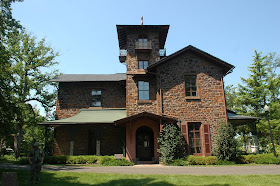How and why did this small town and its college campus become the site of a groundbreaking meeting between the two Cold War superpowers? First, we'll need to take a look at the global climate at the time. The Arabs and Israelis had just fought the Six Day War, with the United States and the USSR taking opposing sides; the Vietnam War was heating up, as well. Many people feared that the unrest would ultimately result in a military showdown. Diplomats realized that much could be gained by getting U.S. President Lyndon Johnson and Soviet Premier Alexi Kosygin in the same room to discuss these issues as well as both sides' missile defense systems.
Conveniently, Kosygin planned to be in the United States in late June to address the United Nations in New York. While open to talking with LBJ, he refused to go to Washington D.C. to do it. Johnson was equally as adamant about not traveling to New York to talk with his Soviet counterpart. Somewhere along the line, a compromise was drawn: meet midway, in New Jersey.
Stopping at the John Fenwick Rest Area wasn't an option, obviously, so Governor Richard Hughes' staff aides quickly cast about South Jersey looking for a suitable location for two world leaders to chat for a few days. Glassboro State College suited the bill: it was close enough to a major airport, had good road access and appropriate meeting space. Students and much of the faculty had left for the semester, with final exams and commencement ceremonies already done.
 |
| Originally the home of glass company owner Thomas Whitney, Hollybush later served as home to Glassboro State College's presidents before its appearance in world politics. |
For ten hours stretching
 between June 23 and 25, Johnson and Kosygin discussed a variety of issues, including possible Vietnam peace negotiations, the Middle East conflict and a potential arms agreement. No formal announcements were made at the conclusion of the summit, but the meeting was widely viewed as a positive development in thawing the Cold War. As Johnson was quoted as saying, "It does help a lot to sit down and look a man in the eye all day long and reason with him, particularly if he's trying to reason with you."
between June 23 and 25, Johnson and Kosygin discussed a variety of issues, including possible Vietnam peace negotiations, the Middle East conflict and a potential arms agreement. No formal announcements were made at the conclusion of the summit, but the meeting was widely viewed as a positive development in thawing the Cold War. As Johnson was quoted as saying, "It does help a lot to sit down and look a man in the eye all day long and reason with him, particularly if he's trying to reason with you."How did all this affect Glassboro? According to an alumni magazine account published 30 years later, many incoming freshmen chose to come to the school in the years following, based on what the Summit had revealed about Glassboro State. Who knows if they were expecting another presidential visit, or maybe other notable events, but one thing's for sure: this little Gloucester County town would always have its place in world history.
No comments:
Post a Comment
Note: Only a member of this blog may post a comment.